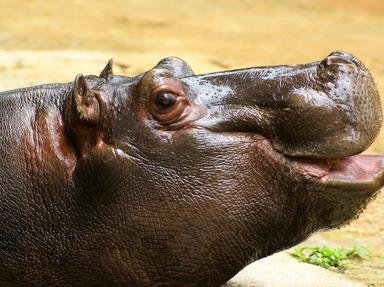Quiz Answer Key and Fun Facts
1. "Tired of being drab? Eat your way to a vibrant pink!" When you click, you find an ad for a book promising that this one weird food will turn your feathers from dull grayish white to bright pink in just weeks. There are even before-and-after pictures of the long-legged author wading in a lagoon, and she does look very pink afterwards. What animal authored this book?
2. "Germaphobic thief stops to wash loot, gets nabbed." A photo shows the masked thief caught in the glare of a camera flash, hunched over a kiddie pool, washing the garden produce he has stolen. What animal is he?
3. "Family vows to keep wild lifestyle if it kills them." The article begins: "Their cousins live in houses, sleep in beds, eat cooked food, and work normal jobs in law enforcement, on farms, helping the disabled or being companions. But this branch of the family lives homeless in the woods, hunting and eating raw meat. 'We don't hate people; we're afraid of them,' said one, wearing the family's characteristic gray fur. 'They've chased us out of most of Europe and America. But we'll never wear sweaters or play ball. I hope people are starting to respect that and will just let us be.'" What animal belongs to this wild family?
4. "Baby born after only five weeks in womb; mother carries it everywhere in pouch for next eight months." The video interview shows the older, healthy baby peeking out of the pouch, while the mother says she didn't mind the effort to save her little Joey and in fact is pregnant again. The family is vegetarian, and the father enjoys boxing. They both have done some modeling for Australia tourism brochures. What kind of animal is this devoted mother?
5. "This one weird trick baffles predators every time." Who wouldn't like to learn that? When I clicked, I discovered that it isn't fully revealed--you have to pay for that--but it seems to involve obscuring yourself in a dark cloud. The article is written by someone who's obviously very intelligent. The idea seems as if it would work only underwater, though. If you buy the full report, you get two others free: "How to Regenerate a Missing Arm so You Always Have Eight" and "The Expert's Guide to Mimicking Anything." What animal wrote the reports?
6. "You'll never believe how this flier navigates in the dark!" The article explains the answer is sonar. I'm not sure how unbelievable that is, but the most entertaining part is an accompanying video, where the petite subject being interviewed won't talk about her sonar and instead rants about the unfair bad reputation she has gotten from her cousins in South and Central America, who drink blood. Wearing a neat brown fur suit, she says her North American family should be praised for all the harmful insects they've helped control. What animal is she?
7. The teaser says: "Emperor swims nude in frigid water." When you click, the article begins "Sporting only black and white feathers..." and continues about the emperor's skinny dip in Antarctic waters. What animal is it talking about?
8. "He survives deadly cobra bite... three times!" The article starts with a quote: "I'd do it again. They don't scare me." Apparently, the little fellow is immune to cobra venom and is happy to dispatch them from homes for just the cost of room and board. But what he really wants is a green card. "They won't let me in the United States any more after that little incident in Hawaii. How did my family know they wanted us to kill only rats and not all those other tasty creatures?" Apparently he can't legally immigrate to Australia or many other countries either, so he is stuck in his native country of India and the surrounding areas. What animal is he?
9. "He's 100 years old and spry as ever. His secret is..." I thought it would be some special diet or clean living, but no. When I clicked, I found that his secret is avoiding accidents, such as tumbling over a bank, landing on his back and being unable to turn over. He also tries to stay away from hunters. He claims his father met the famous naturalist Charles Darwin when Darwin visited the family home in 1835. He hopes to live another 50 years before he starts feeling old. What animal is he?
10. "Live animal mistaken for stuffed bear!" I expected at least a mauling or something, but the video just shows a little girl at the zoo crying because her parents won't buy her the big stuffed bear. That will teach me not to fall for internet hype. The admittedly adorable and cuddly-looking black and white bear ignores her and keeps munching bamboo shoots. What animal is it?
Source: Author
littlepup
This quiz was reviewed by FunTrivia editor
guitargoddess before going online.
Any errors found in FunTrivia content are routinely corrected through our feedback system.


